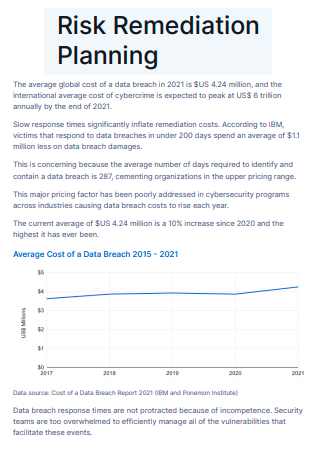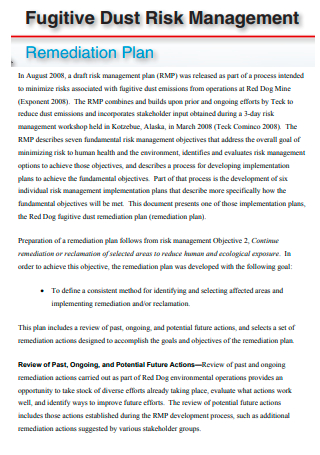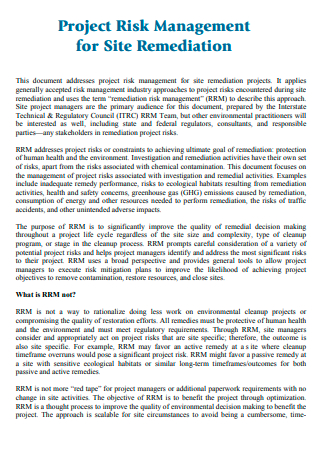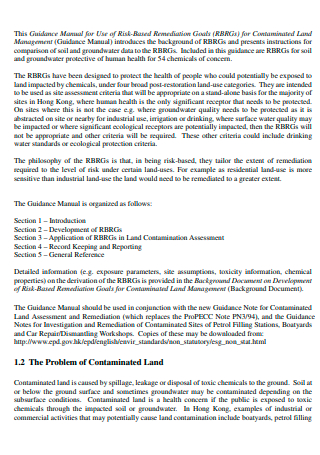3+ Sample Risk Remediation Plan
FREE Risk Remediation Plan s to Download
3+ Sample Risk Remediation Plan
What Is a Risk Remediation Plan?
Benefits of Risk Remediation
Areas Where Remediation Can Be Applied
How To Make a Risk Remediation Plan
FAQS
What’s the Distinction Between Risk Mitigation and Risk Remediation?
Why Is it Necessary to Make a Risk Remediation Plan?
What is The Difference Between Remediation and Restoration?
What Is a Risk Remediation Plan?
A risk remediation plan is a document that enumerates ways to prevent threats from occurring in the first place. It develops solutions to assist avert a possible or existing crisis. Which can be used in a wide range of industries. As an example, during a food safety inspection, an issue was discovered. A remediation strategy includes all remedial efforts aimed at resolving the risk found. Risk remediation initiatives, as opposed to risk mitigation, try to prevent an undesirable outcome from developing. When it does occur, the mitigation plan is now in place. However, this is more difficult to apply because risk assessment based on early assumptions can be inaccurate. But addressing a risk as soon as possible prevents any potential loss from occurring.
Benefits of Risk Remediation
The way we react to a situation can either lessen or increase its severity. In business, “time is money,” and the longer you wait to neutralize an unfavorable scenario, the more damage will be done. That is also evident in our daily lives. The more we put off doing something, the more it gnawed at the back of our minds. And the more difficult it is to begin taking a step forward. This is where risk management comes in. It is not simply a preventative action plan or a contingency plan; it also aids in the complete eradication of the threat. As long as it is possible to make it completely disappear. And if that isn’t enough to persuade you, consider the following advantages.
Areas Where Remediation Can Be Applied
Remediation isn’t simply for project management and planning. There are numerous areas that use the remediation procedure to eliminate risks and problems. To put it another way, it can be used to nearly everything. However, the industries listed below are just some of the most common that could benefit from remediation initiatives.
How To Make a Risk Remediation Plan
Creating a risk remediation plan is a worthwhile task. It not only acknowledges the possibility of weaknesses being exploited, but it also demonstrates the foresight to plan ahead of time. One could stop the damage by developing plans and increasing security measures. In extraordinary circumstances, it may be possible to remove it. The primary goal of remediation is to prevent something from happening. Here’s how to create a risk assessment remediation plan. Or simply a plan for remediation.
-
Step 1. Acknowledge Potential Risks
This is the most important and significant component. It is not merely recognizing vulnerabilities, but also identifying the locations where they may exist. A general remediation plan is hard to formulate. It would not work as well as it should. As a result, remediation programs are specializations in their own respect. For example, suppose you’re developing a cyber security remediation plan. That means you are a member of that department, specializing in cyber security. However, there are numerous sorts of cyber security, such as network security, cloud security, and even IoT security. And because their security features can vary substantially, dealing with them cannot be done in a general manner. Recognizing which parts pose a danger in these areas is only the first step toward developing a remediation plan. This might be accomplished more efficiently by assigning multiple employees to manage each of their individual risks. The divide-and-conquer tactic would be effective.
-
Step 2. Create a Systematic Risk Management and Classification
Risk analysis would reveal whether there are risks in a selected point. It also develops methods for identifying and isolating threats. As a result, the next step would be to isolate and categorize their priority. This is critical in industries that deal with a high number of vulnerabilities in their systems. Because the remediation procedure can be time-consuming, so can reducing all the hazards involved. So, by developing levels and classifications, it may be possible to address what the main priorities are. And these are the priorities that pose the most danger and damage. As a result, they should be addressed as soon as they are detected. Developing a systematic risk management strategy also enables for a more efficient procedure. Except in emergencies, any recognized risk should be subjected to a due process. After one has been corrected or mitigated, it is easier to move on to the next.
-
Step 3. Create Remediation Strategies
Aside from the magnitude of potential threats, speed is also important. Thus, methods should be layered to cover as many bases as feasible. The remediation process would not go as smoothly unless accurate predictions and classification were made. As a result, layering methods allows for better implementation. During remediation, reaction speed is critical. The strategies must not only mitigate, but also entirely correct the problem. This should always be the focal point of any remedial efforts.
-
Step 4. Address Additional Remediation Efforts
Subsequently, writing each strategy could be perplexing. And so, it must also be properly categorized in the strategy. Additionally, any extra observations or useful recommendations could be included at the end. It could be other far-fetched possibilities that are far outside the parameter set yet could still occur. It states unequivocally that nothing has been ignored. Alternatively, there is a strategy for practically everything. Which, in turn, makes it easier to implement.
FAQS
What’s the Distinction Between Risk Mitigation and Risk Remediation?
When threats occur and have negative consequences, a risk mitigation plan is required. This is because risk mitigation is a method that aims to minimize the repercussions to suffer as little damage as feasible. Risk remediation, on the other hand, attempts to prevent the risk from occurring in the first place. Or, if it is excessive, control it before it occurs. The ramifications would be minimal in this case.
Why Is it Necessary to Make a Risk Remediation Plan?
A risk remediation plan is essential when dealing with various and extremely severe risks. The fact that it may be used in a variety of industries is an added plus. A risk remediation plan develops systematic techniques to treat problems before they materialize. Rather than coping with the implications after the event risks before they could occur. As opposed to dealing with the consequences after it happens.
What is The Difference Between Remediation and Restoration?
Remediation, although attempting to reverse the damage, ends there. Restoration is when it strives to return it to its original state. The most obvious example is environmental degradation. Attempting to restore it to its original excellent condition is what restoration entails. Prior to that, remediation occurs through halting environmental damage.
There is a lot of uncertainty about what the risk remediation definition is. Or a clear distinction between risk remediation vs mitigation. It is mostly a strategy or endeavor to thwart a threat. Or to keep a risk from occurring. As a result, it is a significant technique. So get started right away by downloading the free risk remediation plan above!




